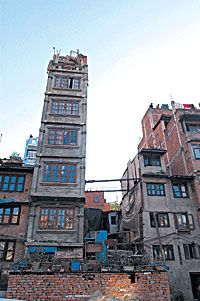|
|
Kathmandu has ranked first in a study of cities most vulnerable to earthquakes, followed by Istanbul, Delhi, Quito, Manila, and Islamabad.
When it comes to earthquakes, a magnitude 6.0 rumble in San Francisco may shake the same as a 6.0 in Delhi. But you're far more likely to die in India. Blame that mortality spread on exponential population growth, increasing poverty, and lax or non-existent building codes. In short: poor nations run far greater risk of fatalities than rich ones.
GeoHazards International, a nonprofit research group aiming to reduce suffering due to natural disasters, measured the lethal potential of seismic disasters facing small and large cities in Asia and the Americas-areas most at risk for seismic calamity. The sample cities spanned both developed and developing countries. Variables measured: building frailty, potential for landslides and fires, and the rescue, firefighting and life-saving medical abilities of local authorities.
The only first-world cities on the list were in Japan: Tokyo, Nagoya and Kobe. Fatalities in these cities were estimated in the hundreds, not the thousands.
Events since then show the estimates to be fairly accurate, if not low. The magnitude 7.6 quake that struck the Kashmir region of Pakistan in October 2005 killed more than 73,000 people, many in remote parts of the country, not dense urban centers like Islamabad. Geohazard's study predicted a 6.0 hit on Pakistan's capital would kill 12,500 people.
GeoHazards warned the problem would become worse, citing a study of estimated earthquake fatalities based on population growth and construction changes in northern India. One scary finding: A magnitude 8.3 earthquake striking Shillong might kill 60 times as many people as were killed during a similar size quake that hit in 1897, even though the population of the region has increased by only a factor of about eight since then. Reason: The replacement of single-story bamboo homes with multistory, poorly constructed concrete-frame structures, often on steep slopes, has made the population much more vulnerable.
The opposite has happened over the last century in developing nations. Building codes have improved in earthquake-prone regions, as have preparations for disasters. Populations have grown in urban areas, to be sure, but at nothing like the rates in third-world cities, where an influx of rural poor has created increasingly dense living arrangements.
Economic impacts from earthquakes are radically different as well. Geohazards finds the cost of the 1994 California earthquake was about 1 percent of the regional gross domestic product, and the cost of the 1989 Loma Prieta earthquake was only about 0.2 percent of the regional GDP.
By contrast, he pegs cost of the 1972 Nicaragua earthquake at 40 percent of that country's entire GDP, and the cost of the 1986 El Salvador earthquake at 30 percent of that country's GDP.
(FORBES)



